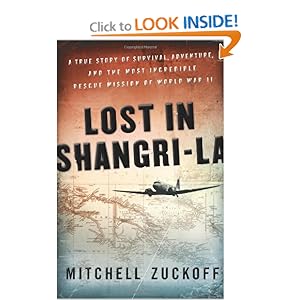World War II, in addition to being The Good War fought by the Greatest Generation, continues to provide a wealth of lessons, images, illustrations, and just good stories for authors to mine and for readers to appreciate. Lost in Shangri-La, subtitled “A True Story of Survival, Adventure, and the Most Incredible Rescue Mission of World War II,” is one of those many stories that can inspire and educate us today, some sixty odd years later.
 The episode took place in Dutch New Guinea (later called Irian Jaya and West Papua, a part of Indonesia) in the waning years of the war, 1945-1946. Twenty-four AMerican servicemen and WAC’s boraded a transport plane for a sight-seeing trip over the Baliem Valley, also called by the service personnel that discovered, Shangri-La Valley because it reminded them from the air of James Hilton’s novel, Lost Horizon. The plane crashed, and three of the twenty-four miraculously survived the crash. However, the three were trapped inside a valley that was inaccessible to airplanes, and between them and the coast where Allied base were, was miles and miles of jungle, home to possibly hostile tribesmen and also possibly filled with Japanese soldiers who had yet to surrender. And to compound the problem of getting back to their comrades, the three survivors were covered with serious burns from the crash that were in danger of turning gangrenous.
The episode took place in Dutch New Guinea (later called Irian Jaya and West Papua, a part of Indonesia) in the waning years of the war, 1945-1946. Twenty-four AMerican servicemen and WAC’s boraded a transport plane for a sight-seeing trip over the Baliem Valley, also called by the service personnel that discovered, Shangri-La Valley because it reminded them from the air of James Hilton’s novel, Lost Horizon. The plane crashed, and three of the twenty-four miraculously survived the crash. However, the three were trapped inside a valley that was inaccessible to airplanes, and between them and the coast where Allied base were, was miles and miles of jungle, home to possibly hostile tribesmen and also possibly filled with Japanese soldiers who had yet to surrender. And to compound the problem of getting back to their comrades, the three survivors were covered with serious burns from the crash that were in danger of turning gangrenous.
The mountains were too high for helicopters. The valley was too narrow for planes to land, and there was no suitable runway anyway. The jungle was too thick fro planes to even spot the survivors from the air. How were the three to be rescued? The story of how and who did it and what the crash survivors encountered in the valley of “Shangri-La” is quite fascinating.
I was reminded of the missionary story, Peace Child by Don Richardson. Mr. Richardson worked with the Sawi people of Papua somewhere in or near the Baliem Valley where the people in Lost in Shangri-La were marooned. He was also in contact with the Dani and Yali tribes, the same peoples with whom the survivors of the Shangri-la plane crash found refuge. After the war, many of these isolated Papuan tribespeople were introduced to Christianity and prepared by missionaries for their inevitable encounter with Western culture.
It was fascinating to get a glimpse of these tribes in their pre-Western-influenced and pre-Christian cultures. Obviously, the coming of Western influences to these tribes has been a mixed blessing. Before World War II the Baliem Valley was largely unexplored and isolated from the rest of the world. Now, although the valley is still somewhat isolated because of its inaccessibility, most of the native people claim to be Christians, and the wars between villages that took place with regularity before are no more the men’s favorite pastime.
At any rate, if you’re interested in these sorts of things—isolated people groups and cultures, World War II stories of adventure and bravery, historic encounters between modern and prehistoric groups of people— Lost in Shangri-La should be just the ticket.
Similar and related books:
The Airmen and the Headhunters: A True Story of Lost Soldiers, Heroic Tribesmen and the Unlikeliest Rescue of World War II by Judith Heimann.
Peace Child by Don RIchardson.
Unbroken: A World War II Story of Survival, Resilience, and Redemption by Laura Hillenbrand.
What is your favorite (true) World War II story?
Unbroken is my favorite. Amazing.
Miracle on the River Kwai is my favorite. It was made into a movie called To End All Wars which I didn’t see because I was sure they wouldn’t show the part that faith played in the book.
@hopeinbrazil: Actually, the movie does a surprisingly good job of retaining the powerful Christian elements of the book. It’s not as good as the book (of course), but it’s still worth a watch. 🙂
I haven’t read many true war stories, other than Holocaust memoirs. I’ve heard a lot of good things about this book, so it’s definitely on my to read list. I’ll link to your review on War Through the Generations.
Pingback: Semicolon’s Twelve Best Adult Nonfiction Books Read in 2011 | Semicolon
The story is crafted from journal entries, photographs, and interviews with the author as we follow the heroic rescue of the survivors and the harrowing details of their survival in a new world. I thought the book was fantastic and very interesting. To think all of this really happened and I’d never heard of the story before, it’s one of those secret treasures you never know existed. I highly recommend it to anyone who loves a good non-fiction read.
Pingback: World War II Novels and Nonfiction – Semicolon